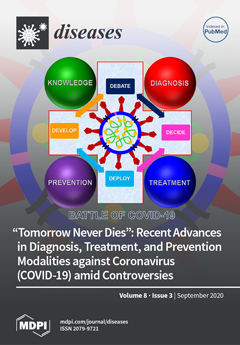Objective: the aim of this pilot study was to test the short-term effect of oral supplementation with a sodium hyaluronate with a large spectrum of molecular weights (FS-HA
®) on the symptoms and functionality of knee osteoarthritis (OA). Methods: 60 subjects affected
[...] Read more.
Objective: the aim of this pilot study was to test the short-term effect of oral supplementation with a sodium hyaluronate with a large spectrum of molecular weights (FS-HA
®) on the symptoms and functionality of knee osteoarthritis (OA). Methods: 60 subjects affected by clinical and/or radiological diagnosis of symptomatic knee OA were consecutively enrolled in a randomized, double blind, placebo-controlled, clinical trial. At randomization visit, at day 28 (visit 2), and day 56 (visit 3), the Western Ontario McMaster Universities Osteoarthritis Index (WOMAC), the Lequesne Functional Index (LFI) and the Visual Analogue Scale (VAS) for pain (VAS-p) were administered to the enrolled patients. Then, patients were asked how many times they used rescue medications (non-steroidal antinflammatory drugs–NSAIDs and/or anti-pain drugs) during the previous 4 weeks. Finally, the range of knee joint motion (ROM) was also instrumentally measured. Results: In FS-HA
® treated subjects, VAS-p, pain and total WOMAC score, LFI and ROM significantly improved compared to the baseline values (
p < 0.05). At 60 days, the VAS-p and the pain WOMAC score were significantly lower after FS-HA
® treatment when compared with placebo as well (
p < 0.05). The FS-HA
® treated subjects significantly reduced the weekly use of NSAIDs and/or antipain drugs when compared to the placebo-treated ones (
p < 0.05). Conclusion: the oral supplementation with a FS-HA
® characterized by a large spectrum of molecular weight was associated with a short-term improvement in symptomatology and functionality of osteoarthritis-affected knees, and associated with a reduction in the use of NSAIDS and anti-pain drugs.
Full article





